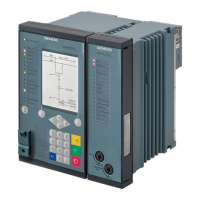Checking the Voltage-Control Function with the Method of Minimizing the Circulating Reactive Current
The following secondary test is used to check the setting values. The current is fed into one voltage controller
respectively and this current has a phase angle of -90° to the voltage.
•
Check also the functional measured values for the circulating reactive current for the voltage controllers
where no current is being fed in.
The following simplification results:
The current on one voltage controller is the total load current (I
load
= I
k
) and therefore the measured circulating
reactive current depends on the primary load current on a transformer:
[fo_ibs_ccm_trafo, 1, en_US]
where:
Total susceptance value
X
k
Transformer reactance on transformer k
The control deviation D
CRCk
resulting from the circulating reactive current is determined in the voltage
controller numerically according to the following formula:
[fo_regelabwdcc, 1, en_US]
The primary current to be fed in at a desired control deviation D
CRCk
results as follows:
[fo_ibs_regelabwd_ccm, 1, en_US]
The current to be fed in is calculated from the following ratio, with the phase angle to voltage being ∠I
act-sec
=
-90°
[fo_ibs_load_cur_prim, 1, en_US]
Example
Table 10-2 Example Values
Parameters Transformer T
1
Transformer T
2
Power system →
VT 3-phase:Rated primary voltage V
CT-prim
22 kV 11 kV
Power system →
VT 3-phase:Rated secondary voltage V
CT-sec
110 V 100 V
Functional Tests
10.10 Commissioning Hints for Voltage Control
1086 SIPROTEC 5, High-Voltage Bay Controller, Manual
C53000-G5040-C015-9, Edition 11.2017

